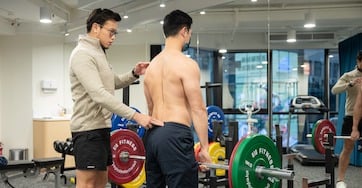Athlete's foot (香港腳) is a condition that affects many individuals, especially those who engage in sports or have active lifestyles. It can cause discomfort, itching, and irritation. It can be easily transferred from one person to another if left untreated.
In this comprehensive guide, we will explore what causes athlete’s foot, the healing stages, discuss the best treatments, delve into home remedies, and provide insights on measures to help treat athlete's foot at home.
Understanding athlete's foot
Athlete's foot, also known as tinea pedis, is a contagious fungal infection that primarily affects the skin on the feet. The fungus thrives in warm, moist environments, so grows well in places such as locker rooms and around swimming pools. Usually, it is picked up by direct skin contact with infected surfaces or contact with contaminated items like socks, shoes, or towels. If the fungus infects your skin, and the environment around your foot is ideal for fungus growth (such as sweaty sports trainers!) this can lead to increasing irritation as the infection spreads causing the symptoms of athlete’s foot.
Athlete's foot symptoms
Itching and Burning Sensation
The most common symptom of athlete's foot is intense itching, especially between the toes, as this tends to be the part of the foot with the most heat and moisture and the least ventilation. The affected area may also experience a burning sensation
Redness and Scaling
The skin affected by athlete's foot often becomes red, inflamed, and may appear cracked or scaly. The skin may become dry and flaky, leading to peeling, which can become very uncomfortable.
Blisters and Ulcers
In more severe cases, athlete's foot can form blisters or ulcers. These can be painful and cause additional symptoms such as oozing or crusting. If this happens, you should seek medical attention as you may have a secondary bacterial infection or another condition that needs different treatment.
Foul Odor
Athlete's foot can contribute to a foul odor from the affected feet. This odor is typically caused by the interaction of sweat and the fungi present on the skin
Itchy and Peeling Skin on the Soles
In some instances, athlete's foot may affect the soles of the feet, leading to itching, peeling skin, and dryness
Spread to Other Areas
If left untreated, athlete's foot can spread to other body parts, including the toenails, hands, and groin area. This can lead to additional fungal infections such as jock itch or fungal nail infections
Athlete's foot healing stages
To effectively combat athlete's foot, it is crucial to understand its healing stages:
- Initial Stage: At this stage, symptoms may include itching, redness, and a burning sensation between the toes or on the soles of the feet. The skin may appear dry and flaky.
- Progression Stage: Without proper treatment, athlete's foot can progress, causing the skin to crack, blister, and peel. The infection can spread to other foot areas, including the toenails.
- Healing Stage: With appropriate care and treatment, the symptoms will gradually subside, and the skin will begin to heal. Continuing the treatment even after symptoms disappear is essential to prevent recurrence.
Athlete's foot treatment
There are 2 important stages to treating athlete’s foot: anti-fungal medications and hygiene measures.
Stage 1 - Anti-fungal treatments
- Over-the-Counter Antifungal Medications: Topical antifungal creams, sprays, or powders containing ingredients like clotrimazole, miconazole, or terbinafine can effectively eliminate the fungal infection. For most patients, when used as directed and combined with good foot hygiene, these work well.
It is a good idea to avoid using creams with steroids on the area (unless given to you by a doctor) as these can make the situation worse in some circumstances. - Prescription Medications: A doctor may prescribe oral antifungal medications in severe cases or when over-the-counter treatments fail. These medications work from within the body to combat the infection. These may also be needed if the infection has spread to other body areas.
Stage 2 – Foot hygiene
In addition to specific remedies, adopting certain lifestyle habits can aid in treating and preventing athlete's foot. If you have athlete’s foot, remember that it is contagious, and it is important to not go barefoot in communal areas or share socks, shoes or towels with others until after your infection is completely resolved to help prevent spreading it to others.
Here are some valuable tips:
- Keep Feet Clean and Dry: Thoroughly wash and dry your feet, paying particular attention to the spaces between the toes. Moisture provides an ideal breeding ground for fungi, so ensure your feet are completely dry before wearing socks and shoes.
- Wear Breathable Footwear: Opt for breathable, moisture-wicking socks made from materials like cotton or bamboo fibre and shoes made of natural materials like cotton or leather. These materials allow air circulation, reducing the chances of fungal growth. Many sports trainers have small holes in the upper fabric to allow the foot to breathe better.
- Rotate Shoes: Give your shoes ample time to dry out between uses and consider rotating between different pairs to allow them to air out fully. If you have been doing a particularly sweaty activity such as running, training or hiking, try to get out of your sweaty shoes and socks as soon as you can once you are finished. Make sure you also change your socks daily - Fungi can multiply very well in socks that have been previously worn.
- Hygiene: Regularly trim your toenails, keeping them clean and short to prevent fungal infections. If you find this difficult to do yourself, a podiatrist can help. If you go to get pedicures, ensure the place you use has good policies for cleaning the equipment between clients. Avoid sharing towels, socks, or shoes with others to minimise the risk of spreading the infection. Even once your infection has cleared, try not to be barefoot in communal areas such as swimming pools or locker rooms.
- Try not to scratch the skin: the itching in the athlete’s foot can be very intense, and it can be hard not to scratch the area. Itching the skin can cause more irritation and make the itching worse. It can also cause more breaks in the skin barrier and introduce new bugs which can cause another infection on top of the fungal one.
Home remedies for athlete's foot
Patients commonly ask about some home remedies for athlete’s foot. If you prefer to try these options first, they are unlikely to harm you, but at the time of writing, there is only a tiny amount of evidence to suggest that they might be helpful.
Common home remedies like a few drops of tea tree oil in a foot bath (dry your feet well after if you do try this!) or applying garlic paste to the affected area have shown in small studies that they may have some benefit due to the antifungal properties of these substances. Providing you are not sensitive to either of these ingredients, these will be unlikely to harm if you prefer to try a more natural remedy first, but have little evidence for their ability to clear the infection for certain effectively.
Another common one patients ask about is baking soda, either made into a paste and put onto the skin or applied to the inside of socks or shoes in powder form. Whilst some suggest that baking soda can create an environment that is less preferable for fungus to grow in, there is no strong evidence to suggest it is an effective cure.
Tips from OT&P
Athlete's foot can be a bothersome condition, but with the proper knowledge and treatment, it can be effectively managed and overcome. By understanding the causes, healing stages, and important steps of treating the condition, you will hopefully be able to accelerate the healing process and prevent future recurrences.
Remember, if symptoms persist or worsen, it is advisable to consult a doctor for further evaluation and guidance. Mainly if the skin is very irritated and broken, you can be at risk of a bacterial infection on top of the fungal infection which antifungals will not be able to treat.
Take care of your feet and reclaim comfort and confidence in your athletic pursuits.
Reference
- Healthline. Home Remedies for Athlete’s Foot. Retrieved 29 Aug, 2023 from https://www.healthline.com/health/home-remedies-for-athletes-foot
- Mayo Clinic. Athlete's foot. Retrieved 29 Aug, 2023 from https://www.mayoclinic.org/diseases-conditions/athletes-foot/symptoms-causes/syc-20353841
- Cleveland Clinic. Athlete’s Foot (Tinea Pedis). Retrieved 29 Aug, 2023 from https://my.clevelandclinic.org/health/diseases/22139-athletes-foot-tinea-pedis
- MedlinePlus. Athlete's Foot. Retrieved 29 Aug https://medlineplus.gov/ency/article/000875.htm
- Feet the Clinic. All You Need to Know about Athlete’s Foot. Retrieved 29 Aug https://www.feetattheclinic.co.uk/all-you-need-to-know-about-athletes-foot/

 Central General Practice
Central General Practice
 Repulse Bay
Repulse Bay
 Clearwater Bay
Clearwater Bay
 BodyWorX Clinic
BodyWorX Clinic
 Central Specialist Clinic
Central Specialist Clinic
 MindWorX Clinic
MindWorX Clinic
 Partner Clinics
Partner Clinics
 Family Clinic
Family Clinic
 OT&P Annerley Midwives Clinic
OT&P Annerley Midwives Clinic


